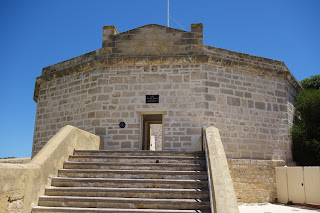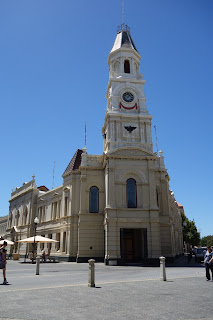Fremantle is Western Australia's chief port, situated at the mouth of the Swan River. Founded by the raising of the Union Jack at Arthur Head on 2 May 1829, by Captain Charles Howe Fremantle of H.M.S. Challenger, he claimed the west coast of New Holland (Australia) as British territory. The first British settlers arrived in early June 1829 to found the Swan River colony.
In a country predominately settled by convicts, it is not surprising that the first permanent building to be built in Western Australia was a prison. The Round House Prison, so named because of it's unusual 12 sided shape, was built in 1831. It was purpose built as a gaol to house locals who broke the law and was used until 1886. The site chosen for this gaol was a headland which overlooked the river mouth. It had eight cells and a jailer's residence, which all opened up into a central courtyard. This was also an obvious place to establish navigation lights and a signalling station.
From 1900 a dropping ball and sound signal were used each day at 1:00 pm to signal the correct time to navigators on ships entering Fremantle Harbour. This procedure was discontinued in 1937 but since 1998 volunteer guides at the Round House have re-enacted the ceremony every day. I was there for the firing of the cannon today, and you can see the flag pole in the background behind the Round House. The flags are flown to welcome vessels of foreign origin to the port of Fremantle. The flag is hoisted to the top of the flagstaff as the vessel enters the heads. It remains aloft for approximately 10 minutes and is then lowered. Fremantle is one of only a few port cities around the world that still undertakes this courtesy to visiting vessels of foreign origin.
Bathers Beach is the site where Captain Charles Howe Fremantle landed in 1829 and proclaimed the land as British territory. Nowadays it is a great place to swim!
The Whaler's Tunnel below the Round House was built by the Fremantle Whaling Company in 1837 to allow the company easy access between Fremantle town and Bathers Beach.
The limestone Heritage Listed building that is currently the Kidogo Art Institute was built in 1884 as a dangerous goods and kerosene store. It is perched on the sand dunes a few meters from the sparkling waters edge of Bathers Beach.
Fremantle Town Hall was opened in 1887. The opening coincided with the celebration of Queen Victoria's Jubilee and it was formally named as the Town and Jubilee Hall.
The first rail line from Perth to Fremantle opened in 1881. This station building was built in 1907 and today continues to be the hub of Fremantle's public transport system.
This particular street is known as 'Cappuccino Strip' and is renowned for its coffee houses and small restaurants.
The Fremantle Markets opened in 1897, forming a precinct providing handicrafts, speciality foods, dining halls and fish and vegetable markets. Nowadays over 150 stalls are housed in the Victorian-era building, which was listed by the National Trust of Australia and the state's Heritage Council in 1980.
This building was built by convicts in 1861 as a lunatic asylum. It was initially called the Fremantle Lunatic Asylum, and later known as the Asylum for the Criminally Insane. Since then it has also been an invalid depot, a women's refuge home, a naval base during both the World Wars, a technical college and is now the Fremantle Arts Centre.
With a ratio of three convicts to every one free man, the town quickly outgrew the tiny Round House Prison and was forced to build a larger scale prison. The Fremantle Prison was built by convicts in the 1850's and was used continuously as a place of incarceration and punishment for 136 years - until 1991. In 2005 Fremantle Prison was included on the National Heritage List and in 2010 is became the first building in Western Australia to be included on the prestigious World Heritage List.
A re-creation of typical 1855 cell accommodation:
The main prison building was divided into several parts. In the main block, four divisions were created: One Division for short sentences, remand prisoners, and (up until 1970) juveniles as young as 13 years old; Two Division for serious crimes without violence; Three Division for violent criminals and Four Division for murderers and long-term men.
It also had solitary cells
and gallows. The gallows room was the only legal place of execution in Western Australia between 1888 and 1965, with 43 men and one woman hanged in this period.
The original prison contained an Anglican chapel, and a Catholic prison was built later on in the prison's history. Behind the Anglican chapel altar there is a painted representation of the Ten Commandments. The words to the sixth commandment use the unusual translation of "thou shalt do no murder" rather than "thou shalt not kill," the more common interpretation in the Church of England. Given that the gallows were still in regular use, it was felt that "thou shalt not kill" would have been hypocritical.
Many cells and areas of the prison depict prisoners' artwork. Although painting or drawing on walls was originally forbidden, this rule was relaxed in special cases where art was found to calm violent prisoners, and was relaxed generally towards the end of the life of the facility.
Even after only one day, I was very aware of the depth of character that Fremantle possesses.





















No comments:
Post a Comment